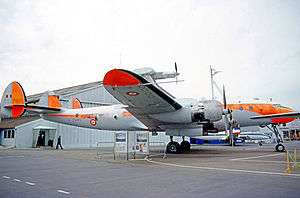Turbomeca Bastan
| Bastan | |
|---|---|
 | |
| Bastan engine undergoing flight tests above a Lockheed Constellation in 1977 | |
| Type | Turboprop |
| National origin | France |
| Manufacturer | Turbomeca |
| First run | 1957 |
| Major applications | Aérospatiale N 262 Nord 260 |
| Developed into | Turbomeca Aubisque |
The Turbomeca Bastan was a turboprop engine developed in France in 1957. Early models developed 650 shp (485 kW), but by 1965 this had been increased to 1,048 shp (780 kW) with the Bastan VII.
Flight tests of some Bastan models were carried out using a Lockheed Constellation flying test bed. The engine's principal applications were the Aérospatiale N 262 (Nord 262) and Nord 260 airliners.
The Bastan was also developed into the Turbomeca Aubisque turbofan.
Applications
- Aérospatiale N 262
- FMA IA 50 Guaraní II
- Nord 260
- Sud Aviation SE.116 Voltigeur
- Sud Aviation SE.117 Voltigeur
Variants
Specifications (Bastan VIC)
Data from Janes's All The World's Aircraft 1965-66.[2]
General characteristics
- Type: Turboprop
- Length: 2,034 mm (80.1 in)
- Diameter: 685 mm (26.97 in) width, 775.5 mm (30.53 in)
- Dry weight: 212 kg (467 lb)
Components
- Compressor: Single-stage axial compressor followed by single-stage centrifugal compressor
- Combustors: Direct flow annular type
- Turbine: Three-stage axial flow
Performance
- Maximum power output: 794 kW (1,065 ehp)
- Overall pressure ratio: 5.83:1
- Specific fuel consumption: 352 g/kWh (0.578 lb/eshp hr)
- Power-to-weight ratio: 3.7 kW/kg (2.3 lb/ehp)
See also
- Related development
- Related lists
References
- Gunston, Bill (1986). World Encyclopedia of Aero Engines. Wellingborough: Patrick Stephens. p. 164.
- Taylor, John W. R. (1965). Jane's All The World's Aircraft 1965-66. London: Samson Low, Marston.
This article is issued from Wikipedia - version of the 6/23/2015. The text is available under the Creative Commons Attribution/Share Alike but additional terms may apply for the media files.